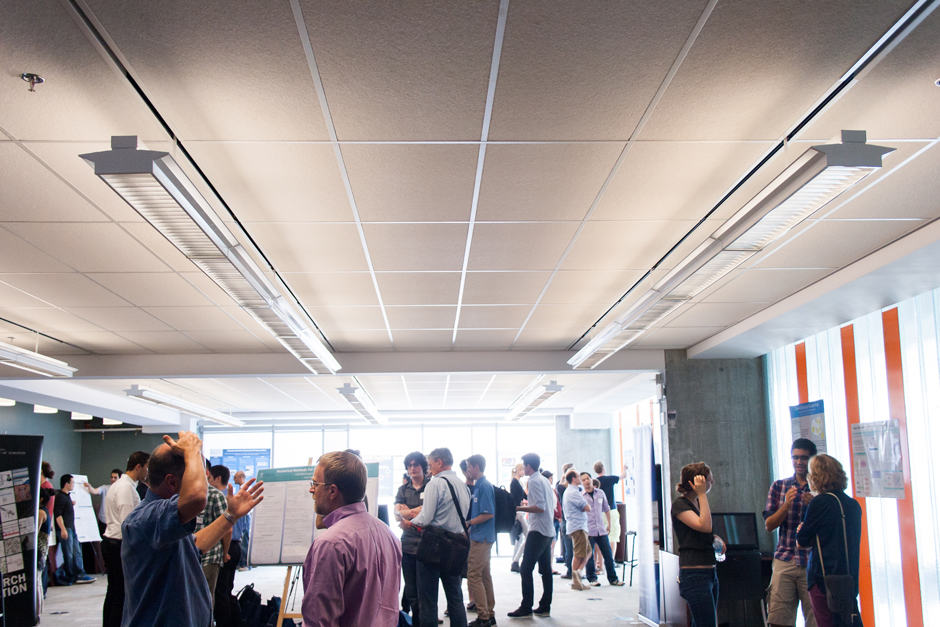The Department of Computer Science recently showcased the results of undergraduate summer research at the Bahen Centre for Information Technology.
The summer research programs offer undergraduate interns a unique glimpse of graduate life at U of T. “It is so awesome that [students] are able to work on these projects. I actually don’t know of any other, at least, Canadian university that has this level of opportunity for undergraduate student research,” said Paul Gries, the associate chair of undergraduate studies at the Department of Computer Science.
“We have everything from theoretical research to really advanced application development on tools that are used by other undergraduate students,” Gries said. He mentions a few different tools, including MarkUs, an online assignment submission and marking tool created and used by computer science students.
In addition to MarkUs, the Python Classroom Response System (PCRS) was also showcased. Olessia Karpova, a fourth-year student in the Department of Computer Science who worked on upgrading the system, explained its function.
“We created an online classroom, essentially; it’s going to be used in our introductory computer science courses,” said Karpova. “Instructors can lay out learning modules consisting of text resources, video resources, multiple choice questions, and different [programming] languages.”
Enhancing accessibility is one of the goals of the PCRS. “This helps the students learn; they can access the learning resources from wherever they want to, whenever they want to — watch the videos as many times as they want,” said Karpova.
“Coding practice is very important,” said Karpova. By providing students with immediate feedback on their performance, the tool helps both the students, who can improve by learning from previous mistakes, and the instructors, who can see where students are struggling most and target those areas of the course material.
The PCRS was first created at UTM two years ago for in-class use, so that instructors could gauge the level of students’ understanding. “Then we took it one step further and developed the self-study modules that were used instead of the laboratory component in first-year computer science, last year. And this year, again, we are taking it another step further,” said Karpova.
“We are giving the instructors more freedom to create the content that they want and we’re giving students more opportunities to learn without being tied to a particular lecture hall or a particular lab section,” Karpova concluded.
Undergraduate student Ian Stewart-Binks worked with PhD student and lecturer David Liu to create Coursography, a tool aimed at guiding students through their university careers. Stewart-Binks explains that the tool has two components, the first being a graph displaying courses offered by the Department of Computer Science, with a pre-requisite tracker built in; and the second being somewhat similar to a scheduler or timetable generator.
“The graph is only available to [computer science] students, but the timetable creator is available to everybody in Arts & Science. It supports 2,337 courses,” Stewart-Binks said.
Students also developed biomedically-relevant tools, such as Karan Dhiman’s algorithm for calculating the speed of blood flow from CT scans, and Filip Miscevic’s clinical diagnostic tool, which is designed to explore other databases with multi-dimensional patient data.
The social sciences also came into play at the showcase. Erin Grant explored gender differences in language abilities and child-directed speech. She used computational methods to analyze the speech of caregivers and parents as directed to young boys and girls.
Accessibility needs were brought to the forefront with the Accessible Large-print Listening and Talking (ALLT) device, which is an accessible e-book reader designed to be used by older adults. “There’s a lot of things that you have to think about, in terms of interfaces and making the device friendly for a group of people who are stereotypically not used to technology,” said Jaisie Sin, a fourth-year undergraduate studying computer science and neuroscience. Sin’s project is one of many at the Technologies for Aging Gracefully Lab at U of T.
According to Gries, undergraduate research showcases breed innovation among students. “First-year students will maybe start thinking about seeing what they can do about getting to know professors, finding out about research so when they get to be third- and fourth-year students, they get to do these projects,” said Gries.


